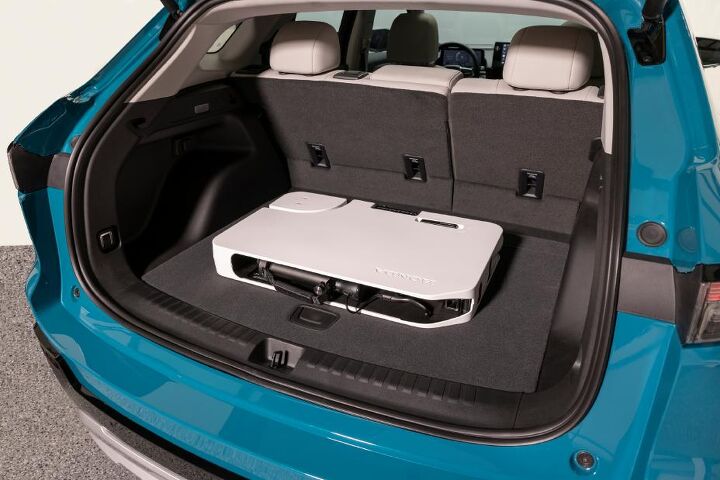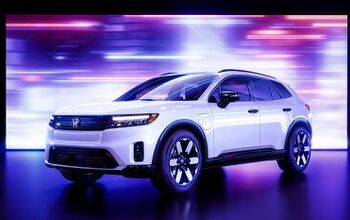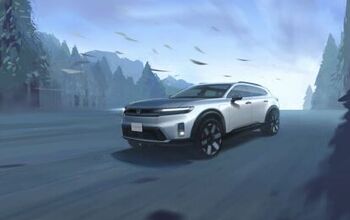Honda Previews the 2024 Prologue

Honda has formally unveiled the all-electric Prologue, indicating that the brand hasn’t given up on electrification. The midsize crossover boasts an agreeable estimated range of (up to) 300 miles and is designed to cater to more mainstream tastes.
As a preeminent manufacturer of modestly sized combustion engines, it makes sense that the company would want to stick to what it knows best. Like several other Japanese brands, Honda has been hesitant to embrace electric vehicles with the same zeal as its European or American rivals. However, external pressures are beginning to force the issue, and this seemed an agreeable solution for the company.
By relying on General Motors’ Ultium battery platform, Honda gets to field an EV boasting a competitive range while bragging to regulators about products being manufactured in North America. Though the vehicle itself will be assembled in Mexico, those Ultium units are technically a collaboration between GM and South Korea’s LG Energy Solution.
That’s “American Made” in the vaguest of senses. But it should be good enough to warrant government incentives under the EV tax credit scheme.
Still, it’s the vehicle itself that will determine success on the market and Honda seems to have something worthy of consideration on paper.
The 2024 Prologue comes with either a single-motor front-wheel-drive configuration or a dual-motor all-wheel-drive setup — the latter of which is supposed to yield a factory estimated 288 horsepower and 333 pound-feet of torque.
Power figures for the front-wheel drive version have not been revealed yet. However, it will undoubtedly be less powerful and weigh less. As Honda clearly wants to lead with the biggest numbers, it has said the single-motor model with a 85.0-kWh battery pack should offer a maximum range somewhere around 300 miles. Anticipate a little less on the dual-motor variant with everything else being even.
We can also do a little guess work with the help of the forthcoming Chevrolet Equinox EV the Prologue shares its platform with. GM is pegging the electric Equinox at 210 horses and 243 pound-feet of torque, numbers that may be mimicked by Honda’s front-drive EV.
Considering that the vehicle will assuredly weigh over 4,000 pounds, that’s not likely to make the base model all that thrilling. Though it’ll be enough to get where you need to be and the spicier all-wheel drive model should be able to offer some thrills below 60 mph. We could certainly be wrong. But the specs we’ve seen and the general theme of this car seem to indicate it's trying to emphasize practicality.
This is also represented by the Honda’s shape. At 192 inches long, the Prologue is larger than both the CR-V and the larger Passport. Its status as an EV also means some interior space can be freed up. It’s also quite wide at 78.3 inches with a wheelbase of 121.8 inches.
Honda said the EX trim should offer 25.2 cubic feet of cargo space behind the rear seats and 57.7 cubic feet with them folded. That’s not as good as we were expecting from the brand. The smaller CR-V boasts more room for cargo in both cases while the larger Passport absolutely demolishes the Prologue in terms of maximum cargo capacity.
If you’re wondering where the space went, the Prologue has a relatively low roof height (it kind of resembles a boxy station wagon at just 64.7 tall) and seems to have relegated a fair bit of room for added comfort. It also has no forward storage (or frunk) due to how the front-mounted motor has been engineered. However, legroom is supposed to be more than ample in both rows according to those that have been inside.
This may not be a bad trade off. Limited range and long charging times tend to make EVs a poor fit for long-distance driving where one would bring a lot of luggage. Honda may have designed the Prologue to be a comfortable family commuter with the ability to occasionally swallow up larger objects. At any rate, we doubt anybody in the market for one will be worried about how it handles a 1,200-mile family road trip.
That said, Honda’s EV is supposed to recoup 65 miles of range in 10 minutes when attached to a DC fast-charger pumping out the maximum 155 kW. Assuming you have reliable access to that kind of power source, that’s not bad. But most people will still be plugging in at home, where overnight charging is the norm.
There’s not much to say about the design. Honda’s current design language is tastefully understated and quite handsome. The Prologue is a good looking vehicle (both inside and out) without needing unnecessary adornments.
Trim levels are said to include EX, Touring, and Elite. But they’re all fairly well equipped since EVs tend to lean into novel technologies wherever possible. Dual 11.0-inch digital displays are standard across the board, as is Apple CarPlay and Android Auto. Honda has also thrown every driver assistance feature it has at the model.
A base Prologue comes with heated front seats, dual-zone climate control, wireless smartphone charging, power driver’s seat, and just about everything you’d find in any other modern automobile. Stepping up the trim ladder opens up the door to leather upholstery, memory seats, 12-speaker Bose sound system, sport driving modes, heated steering wheels, head-up displays, and more.
Pricing hasn’t been announced yet but everyone anticipates the 2024 Honda Prologue to start just above $46,000. How much room there is between that at the top-trimmed models is anybody’s guess.
Vehicle pricing has gotten notoriously difficult to predict recently but asking $55,000 for the Elite seems plausible. However, dealers are going to price them based on demand and we’ve seen some EVs being discounted. If the Prologue is a huge success, it might be years before they’re priced reasonably. If it’s a flop, then dealers are going to be discounting them heavily to get them off the lot.
[Images: Honda]
Become a TTAC insider. Get the latest news, features, TTAC takes, and everything else that gets to the truth about cars first by subscribing to our newsletter.

A staunch consumer advocate tracking industry trends and regulation. Before joining TTAC, Matt spent a decade working for marketing and research firms based in NYC. Clients included several of the world’s largest automakers, global tire brands, and aftermarket part suppliers. Dissatisfied with the corporate world and resentful of having to wear suits everyday, he pivoted to writing about cars. Since then, that man has become an ardent supporter of the right-to-repair movement, been interviewed on the auto industry by national radio broadcasts, driven more rental cars than anyone ever should, participated in amateur rallying events, and received the requisite minimum training as sanctioned by the SCCA. Handy with a wrench, Matt grew up surrounded by Detroit auto workers and managed to get a pizza delivery job before he was legally eligible. He later found himself driving box trucks through Manhattan, guaranteeing future sympathy for actual truckers. He continues to conduct research pertaining to the automotive sector as an independent contractor and has since moved back to his native Michigan, closer to where the cars are born. A contrarian, Matt claims to prefer understeer — stating that front and all-wheel drive vehicles cater best to his driving style.
More by Matt Posky
Latest Car Reviews
Read moreLatest Product Reviews
Read moreRecent Comments
- Bkojote Hi, actual city planner here. Congestion pricing In NYC? Yes. Hell yes. Absolutely hell yes. Like empirically we've already got proof the answer is yes, there's not even a discussion about this anymore, the Robert Moses experiment is 50+ years old. We might as well be arguing if the earth is flat. Now build the freaking rail link from LGA airport I don't want to be inhaling car freshener fumes from my crappy Uber.
- MaintenanceCosts In big cities, there's just not enough space for everyone to drive a car. That's just geometrical reality and you can't change it. So you have to allocate the street space in one way or another. Right now, it's allocated to those who are the most willing to wait in congestion, and they pay the price for the street space in their time. Under congestion pricing, it's allocated to those who are most willing to pay for it in money. (And there is a lot more capacity overall given the lack of gridlock.) If you have a better way to allocate it than either of the above, every city planner is all ears.
- Ajla Maybe, but with them being unpopular at a macro level I doubt you'll be seeing them in the US. If this couldn't get over the finish line in New York then good luck in other places. I think urban planning advocates really need to focus on nonpunitive ideas going forward. "Let's make driving more sh*tty and/or expensive" just isn't going to find a broad audience.
- Oberkanone I want to see knobs for volume control and tuning.
- 28-Cars-Later Nope, but we're getting close again to the time of heads on pikes.







































Comments
Join the conversation
Wishing for the day of open source software in EVs, including the OS. Lets have some transparency in the algorithms and controls. No Fair data hoovering my phone when connected.
I'm also wondering at the level of CANBus components in this vehicle.
I'm confused, isn't a Prologue a preview? This would be a preview of a preview.